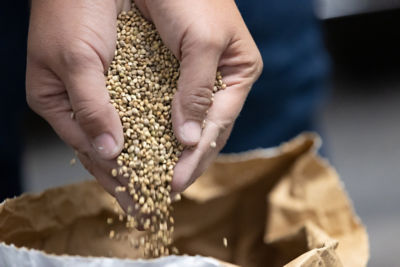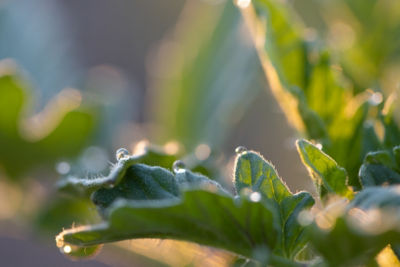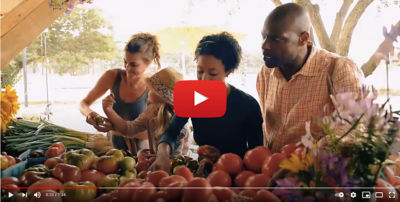Click here to download a PDF version of this spotlight.
» Bacterial wilt of tomato is one of the most important bacterial diseases of tomatoes in tomato growing regions worldwide.
» Bacterial wilt causes a rapid wilt and eventual collapse of tomato plants, resulting in substantial yield losses.
» Using disease-free transplants, cultural practices, and resistant rootstocks can help manage bacterial wilt of tomato.
Bacterial wilt of tomato and other solanaceous crops can cause substantial economic losses for producers.1 The disease is caused by the Ralstonia solanacearum species complex, which is ranked as one of the most important groups of plant pathogenic bacteria.2 The R. solanacearum complex is widely distributed in tropical and subtropical regions, causing serious losses on several crop and ornamental plant species. The incidence and severity of bacterial wilt of tomato has increased in recent years in states such as North Carolina.1,4
 igure 1. Wilting symptoms from Ralstonia solanacearum infection. Rebecca Melanson, Mississippi State University Extension, Bugwood.org
igure 1. Wilting symptoms from Ralstonia solanacearum infection. Rebecca Melanson, Mississippi State University Extension, Bugwood.org
SYMPTOMS
The initial symptom of bacterial wilt is the wilting of young leaves during the heat of the day, with recovery overnight. If conditions are favorable, symptoms quickly progress to a general wilting, yellowing, and eventually a complete plant collapse (Figure 1).1,3 Splitting affected stems lengthwise may reveal long, narrow, yellow to brown streaks in the vascular tissue (Figure 2). A milky white ooze may exude from affected stems cut crosswise, and streams of bacteria may flow out of cut stems suspended in water (bacterial streaming) (Figure 3).1 Adventitious roots can form on stems of infected plants when conditions result in slower disease development.4 Infected roots can turn brown and decay, and the entire root system may eventually develop brown rot symptoms. Symptoms are usually most severe when daytime temperatures are high (85° to 95°F). Sometimes infected plants - including seedlings for transplanting - can remain symptomless for extended periods, which can be problematic when evaluating seedlings prior to transplanting.1
 Figure 2. (A) Vascular discoloration of an infected tomato stem. (B) Bacteria streaming from an infected stem. Gerald Holmes, Strawberry Center, Cal Poly San Luis Obispo, Bugwood.org
Figure 2. (A) Vascular discoloration of an infected tomato stem. (B) Bacteria streaming from an infected stem. Gerald Holmes, Strawberry Center, Cal Poly San Luis Obispo, Bugwood.org
THE PATHOGEN (S)
The Ralstonia solanacearum complex is a diverse group of bacteria that are able to infect over 200 plant species in over 50 plant families. Strains of these bacteria have been classified into races, pathovars, and biovars based on differences in host range, virulence, physiological characteristics, and genetic makeup. Tomato infecting strains have been placed in races 1 and 3 and classified in biovars 1, 2, 3, and 4. Isolates from North America have been mostly identified as biovars 1, 3, and 4 in race 1. These isolates typically have wide host ranges. Race 3 (biovar 2) is mostly found in Asia and Africa and has a more limited host range. Race 3 is present in some areas of Latin American and has been found in the U.S. but is now considered to be eradicated in the U.S.1,3 However, studies have shown that using host range and pathogenicity are not reliable for designating the race or biovar of isolates. Comparing isolates using DNA sequence analysis has resulted in a more reliable form of classification into groups called phylotypes. This has also resulted in the separation of isolates formerly identified as Ralstonia solanacearum into three distinct species: R. solanacearum, R. pseudosolanacearum, and R. syzgii. Tomato isolates found in the Americas mostly fall into the now more narrowly defined R. solanacearum. Isolates belonging to R. pseudosolanacearum are found mostly in Asia and Africa, and isolates belonging to R. syzgii are found in Indonesia and Japan on clove and banana trees.2,5
CYCLE AND CONDITIONS
R. solanacearum is both soilborne and waterborne. It can survive in the soil on the roots of non-host plants, in infected weed hosts, and in infested plant debris. It can also be found in surface water sources, such as ponds and streams. Survival in soil can be affected by factors such as soil temperature, pH, and mineral content. Lower survival rates are seen in calcareous soils with high pH levels, and longer survival times are seen in soils with moderate pH levels and at moderate temperatures. The bacterium does not overwinter well in northern states with low winter temperatures.1,3
The pathogen is disseminated in infested soil on equipment, stakes, and workers’ clothing. It can also be carried in run-off water. Seed transmission is not thought to be important for this disease. However, the pathogen can be brought in on infected transplants, which is an important source of inoculum in northern areas where the pathogen does not overwinter.1,3 The pathogen usually infects tomato plants through root wounds, including the areas where lateral roots emerge, wounds created by insect and nematode feeding, and wounds from equipment and transplanting injuries.1,3 Once in the root, the bacteria move through the root cortex and into the xylem, where they can spread rapidly throughout the plant. The presence of bacteria in the xylem obstructs the flow of water within the plant, resulting in wilting.3,6 High soil temperatures (82 to 95°F) favor higher disease incidence and severity, and R. solanacearum levels in the soil start to drop when soil temperatures fall below 39°F.1,3
MANAGEMENT
With the bacterial wilt isolates from the Americas belonging mostly to R. solanacearum (Race 1), management options discussed here will focus on that group. In warm, southern areas, bacterial wilt is difficult to manage once the pathogen has been introduced into a field because the pathogen can persist in the soil for many years. Therefore, the first priority is to prevent the introduction of the pathogen if it is not yet present. This requires the use of pathogen-free transplants, irrigation only with non-infested sources of water, and clean stakes and equipment.1,3 Surface sources of irrigation water can be treated with chlorine or peroxide products to help eliminate the pathogen. Tools and equipment should be cleaned when moving from one field to another, especially if a field has a history of the disease. The use of pathogen-free transplants and sanitation of equipment can also help prevent the spread of bacterial wilt to fields in colder, northern areas where the pathogen does not overwinter. Resistance to certain strains of the bacterial wilt pathogen has been identified in some tomato varieties, but this resistance is not effective against all strains and can vary with location and environmental conditions. Also, there has been a negative correlation between bacterial wilt resistance and fruit size, with resistant varieties producing smaller fruit than similar varieties lacking the resistance genes. Because of this, bacterial wilt resistance has not been widely used in commercially available tomato varieties. However, tomato breeders are working to break the link between resistance and small fruit, and wiltresistant tomato varieties may be available in the future.1,3,4 Wilt-resistance is used in rootstocks for grafted tomatoes to manage bacterial wilt. Several studies have evaluated the use of bacterial wilt-resistant tomato and eggplant rootstocks for grafted tomatoes to overcome the problem of smaller fruit size associated with resistance.1,3,4,7,8 Using wilt-resistant rootstocks has resulted in lower disease incidence and severity, better growth, and higher potential yields when compared to nongrafted and self-grafted plants.4,7,8 Rotation to non-host crops and planting non-host cover crops can help lower soil populations of R. solanacearum and help reduce disease levels.1,2 Many grass-type species, including corn, are non-hosts and can be good choices as rotation crops. Rye can be planted as a winter cover crop, while sorghum-sudan can be used as a summer cover crop.1 Avoid over-irrigation to help reduce chances of infection and spread of R. solanacearum. Managing weed hosts, planting in welldrained, level fields, and increasing the soil pH to 7.5 can also help limit disease levels and lower pathogen populations.1,3 Shifting planting dates to allow production during cooler periods (plant spring crops earlier and fall crops later) can help slow disease development. Plow in crop debris after harvest to promote the rapid decomposition of infested plant tissues. Soil fumigation with chloropicrin can help provide limited control of bacterial wilt when integrated with other management strategies.1,3 Biological agents have shown some promise as effective management strategies. In particular, the use of bacteriophages, bacteria-infecting viruses, have been shown to suppress bacterial wilt on tomatoes in research trials, and eventually these may be developed into commercial biological control products.2,6
SOURCES
1 Champoiseau, P. and Momol, T. 2009. Bacterial wilt of tomato. University of Florida. IFAS Extension. https://plantpath.ifas.ufl.edu/rsol/trainingmodules/bwtomato_module. html#:~:text=Photo%20
2.-Symptom%20of%20bacterial%20wilt%20of%20tomato%20 caused%20by%20R.,foliage%20and%20stunting%20of%20plant.&text=In%20young%20tomato%20stems%2C%
20infected,%2C%20narrow%2C%20dark%0brown%20streaks. 2 Garcia, R., Kerns, J., Thiessen, L. 2019. Ralstoniasolanacearum species complex: a quick diagnostic guide. Plant Health Prog. 20(1):7–13.
3 Momol, T., Ji, P., and McCarter, S. 2014. Bacterial wilt. In Jones, J., Zitter, T., Momol, T., and Miller, S. (Eds.), Compendium of Tomato Diseases and Pests, Second Edition. American Phytopathological Society.
4 Panthee, D., Kressin, J., and Piotrowski, A. 2021. Identification of potential rootstocks for tomato grafting from bacterial wilt screening trials in North Carolina. Acta Hortic. 1302. ISHS DOI 10.17660/ActaHortic.2021.1302.23.
5 Prior, P., Ailloud, F., Dalsing, B., Remenant, B., Sanchez, B., and Allen, C. 2016. Genomic and proteomic evidence supporting the division of the plant pathogen Ralstonia solanacearum into three species. BMC Genomics 17 (1), 90. https://doi.org/10.1186/s12864-016-2413-z.
6 Nurdika, A. A. H., Arwiyanto, T., Sulandari, S., Joko, T., and Kandito, A. 2023. Grafting tomato with resistant eggplant and bacteriophages treatment to suppress the development of bacterial wilt disease (Ralstonia pseudosolanacearum). Archives of Phytopathology and Plant Protection 56:686-706.
7 Arwiyanto T, Nurcahyanti SD, Indradewa D, Widada J. 2015. Grafting local commercial tomato cultivars with H-7996 and Eg-203 to suppress bacterial wilt (Ralstonia solanacearum) in Indonesia. Acta Hortic. 1069(1069):173–178.
8 Manickam R, Chen J, Sotelo-Cardona P, Kenyon L, Srinivasan R. 2021. Evaluation of different bacterial wilt resistant eggplant rootstocks for grafting tomato. MDPI Plants. 10(1):75.
Websites verified 12/11/2022
ADDITIONAL INFORMATION
For additional agronomic information, please contact your local seed representative. Performance may vary, from location to location and from year to year, as local growing, soil and environmental conditions may vary. Growers should evaluate data from multiple locations and years whenever possible and should consider the impacts of these conditions on their growing environment. The recommendations in this article are based upon information obtained from the cited sources and should be used as a quick reference for informationabout vegetable production. The content of this article should not be substituted for the professional opinion of a producer, grower, agronomist, pathologist and similar professional dealing with vegetable crops.
BAYER GROUP DOES NOT WARRANT THE ACCURACY OF ANY INFORMATION OR TECHNICAL ADVICE PROVIDED HEREIN AND DISCLAIMS ALL LIABILITY FOR ANY CLAIM INVOLVING SUCH INFORMATION OR ADVICE.
5911_279851 Published 11/09/2023




